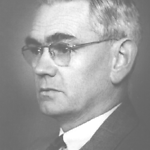Person
Turner, Arthur William (1900 - 1989)
FAA OBE

Arthur William Turner
Details
- Born
- 17 August 1900
Melbourne, Victoria, Australia - Died
- 20 December 1989
Melbourne, Victoria, Australia - Occupation
- Veterinary scientist and Bacteriologist
Summary
Arthur Turner was the Officer-in-Charge of the Animal Health Research Laboratory, CSIR/O Division of Animal Health and Nutrition (later Production), Parkville 1936-1954, he was then Assistant Chief of the Division until 1960. The work he and his collaborators undertook on Contagious Bovine Pleuropneumonia (CBPP) established confidence in the complement fixation test for diagnosis and identified the value of vaccination and its occasional shortcomings. The work was the basis of a national eradication campaign leading to Australia being declared officially free of CBPP in 1973.
Details
* Life Member, Australian Veterinary Association;
* Foundation Life Fellow, Australian College of Veterinary Scientists.
Chronology
- 1923
- Education - Bachelor of Veterinary Science (BVSc), University of Melbourne
- 1924
- Career position - Walter & Eliza Hall Fellow, Veterinary School, University of Melbourne
- 1926 - 1927
- Career position - Rockefeller Foundation Fellow, Institut Pasteur, Paris
- 1927 - 1928
- Career position - Institute of Animal Pathology, Cambridge
- 1928 - 1932
- Career position - CSIR Veterinary Research Institute
- 1930
- Education - Doctor of Veterinary Science (DVSc), University of Melbourne
- 1932
- Career event - Elected Member (Veterinary Science), Australian National Research Council
- 1932
- Award - David Syme Research Prize, University of Melbourne
- 1932 - 1936
- Career position - Head, Animal Health Station, Oonoonbah, Townsville, Queensland [which was on loan from Queensland Department of Agriculture and Stock]
- 1936 - 1954
- Career position - Chief Bacteriologist, CSIR/O Division of Animal Health and Nutirition and Officer-in-Charge, Animal Health Research Laboratory
- 1937
- Career event - Fellow, Australian and New Zealand Association for the Advancement of Science (ANZAAS)
- 1938
- Award - Officer of the Order of the British Empire (OBE) - Senior Bacteriologist at the CSIRO
- 1947
- Career event - President, Section L (Veterinary Science), Australian and New Zealand Association for the Advancement of Science
- 1954 - 1960
- Career position - Assistant Chief, CSIR/O Division of Animal Health and Production (from 1959 CSIRO Division of Animal Health)
- 1954 - 1989
- Award - Foundation Fellow, Australian Academy of Science (FAA)
- 1958
- Award - Gilruth Prize for Meritorious Service to Veterinary Science, Australian Veterinary Association
Related entries
Published resources
Journal Articles
- French, E. L.; and Sutherland, A. K., 'Arthur William Turner 1900-1989', Historical Records of Australian Science, 9 (1) (1992), 49-63. https://doi.org/10.1071/HR9920910049. Details
- Schedvin, C. B., 'Environment, Economy and Australian Biology 1890-1939', Historical Studies, 21 (1984), 11-28. Details
- Turner, A. W., 'Gilruth's Work with the Council for Scientific and Industrial Research, 1929-1936', Australian Veterinary Journal, 13 (1937), 112-115. Details
- Turner, A. W., 'Gilruth Prize award: Arthur William Turner, O.B.E., D.V.Sc., D.Sc., F.A.A.', Australian Veterinary Journal, 34 (8) (1958), 262-4. Details
Resources
- Wikidata, http://www.wikidata.org/entity/Q28062430. Details
- 'Turner, Arthur William (1900-1989)', Trove, National Library of Australia, 2009, https://nla.gov.au/nla.party-1473119. Details
Resource Sections
- French, E. L.; and Sutherland, A. K., 'Arthur William Turner 1900-1989', in Australian Academy of Science Biographical Memoirs, Australian Academy of Science, 2006, https://www.science.org.au/fellowship/fellows/biographical-memoirs/arthur-william-turner-1900-1989. Details
- Ward, C., 'Arthur William Turner', in CSIROpedia, Commonwealth Scientific and Industrial Research Organisation (CSIRO), 2011, https://csiropedia.csiro.au/Turner-Arthur-William. Details
See also
- French, E. L.; and Stewart, D.F., 'Lionel Bately Bull, 1889-1978', Historical Records of Australian Science, 5 (4) (1983), 90-110. https://doi.org/10.1071/HR9830540090. Details
Digital resources
Rosanne Walker; Ken McInnes
Created: 20 October 1993, Last modified: 23 May 2024
- Foundation Supporter - Committee to Review Australian Studies in Tertiary Education
